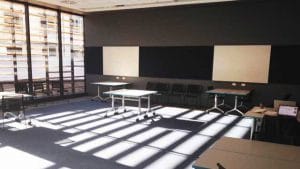
The Abercrombie Sandpit is a new learning space in the Abercrombie Building. We like to think of it as a ‘living, learning laboratory’ where teachers, students and researchers can learn about connections between the physical learning environment and learning activity through observation, experimentation and sharing. The project is being led by Dr Pippa Yeoman from the Centre for Research on Learning and Innovation and Dr Stephanie Wilson from Educational Innovation in Business, University of Sydney Business School.
At the beginning of Semester 1 2018, the furniture in this 30-seat seminar room – comprising desks and chairs of uniform height – was removed to make way for flexible furniture with the potential to support various forms of collaborative and active learning.
What’s in the sandpit?
As learning through active collaboration and shared sense making is valued, the aim was to increase movement through the introduction of diverse furnishings (calculated to seat all concurrently) to accommodate different forms of human interaction, and different heights (3 levels) to promote movement over time.
The sandpit contains:
- soft furnishings: straight and curved couches, and ottomans
- straight and curved desks with writable surfaces and stools
- two high ‘cloud tables’ with writable surfaces and high stools
- whiteboards mounted around the room (existing)
- standard lectern and AV equipment (existing)
Configurations
A number of suggested configurations are currently displayed on a pin board in the Sandpit for staff and students to consider in relation to the kinds of activities they facilitate or participate in during tutorials. While these act as a starting point for those using the room, users are encouraged to explore configurations that best support their learning activities and intended learning outcomes.
Observations in other learning spaces have suggested that homogenous furnishings tend to produce static formations (rows oriented towards the front), and overcrowding around the dominant teaching point, which results in underuse of the perimeter and in some cases a full third of the space directly opposite the main teaching point. The new furnishings in Rm 2280 were introduced to encourage more dynamic formations. The images below provide examples of settings to accommodate a range of group sizes and orientations, and the creation of zones to support different types of activity. They highlight that similar activities can occur across a range of settings, and promote the use of the full floor plate.
#1 the tight conversation: best for shared dialogue as a group, or a one-to-many presentations using a single visual orientation
#3 the punctuated conversation: best for group dialogue, or switching between a one-to-many presentation using a single visual orientation and smaller/larger group discussion over time.
#5 working in groups (small): best for paired dialogue, and reflection in small groups or as individuals.
The research – what are we hoping to find?
Aims
- To create a safe and engaging context in which to test new spatial forms of teaching and learning practice.
- To document and share actionable insights on changes in practice after the introduction of new furnishings to learning space(s) in the Abercrombie building.
Research Questions
Through the project we would like to explore the following questions:
- Does the invitation to experiment with different types of furnishings promote a willingness to engage in innovative forms of teaching and learning practice for students and teachers?
- Does the presence of different types of furniture promote a broader range of valued learning activity, e.g. group formation, engagement, dispersal and regrouping; the use of writable surfaces; and the enrolment of assorted sharing technologies?
- Does this openness lead to a sharing of actionable insights?
This research is informed by theories of situated and distributed cognition (Clark, 2010; Hutchins, 1995), and engages deeply with work that takes a socio-material approach to educational research (De Freitas, 2014; Magnat, 2011; Sørensen, 2009).
What have we learned so far?
This semester, formal observations were conducted in the Sandpit one day a week across six weeks. This involved observing six classes each week from three different units, each belonging to a different discipline (Finance, Work and Organisational Studies, and International Business). While a formal analysis of data has not yet been conducted, early observations suggest the following:
- the setup doesn’t disadvantage anyone
- eye-contact is very different (much better) in this space
- the setup promotes proximity between people and this supports productive interactions
- the setup supports a very powerful shared focus of attention
- while some teachers and students have not altered the configuration of the room, others have made small adjustments or more significant ones to support different kinds of learning activity
- the furniture offers many options, some of which are still to be tested in class
What is epistemic fluency and what does it look like?
Epistemic fluency is defined by Markauskaite and Goodyear as “the capacity to understand, switch between and combine different kinds of knowledge and different ways of knowing about the world”. The following images demonstrate epistemic fluency in various forms in the Abercrombie Sandpit.
What’s next?
The next step of the project is to conduct walking interviews (Riley & Holton, 2016) with the lecturers and tutors who taught in the room this semester to learn about the evolution of their teaching and learning practices in situ (Wall, Hall, & Woolner, 2012; Woolner et al., 2010).
For more information on the Abercrombie Sandpit you are welcome to contact Stephanie Wilson [email protected] or Pippa Yeoman [email protected].
















